How to perform butt welding of polyethylene pipes: instructions on how to carry out the work
Polyethylene pipes with a diameter of 2-120 cm are often used for laying water pipes, gas pipelines, and storm sewer equipment. They are durable, resistant to corrosion, lightweight, and easy to install. Welding is used to connect products. It can be of different types. The most popular is butt welding of polyethylene pipes. It ensures a sealed and aesthetically pleasing seam.
Usually, specialists are hired to lay the highway. But would you agree that professional services are not cheap? In addition, not all craftsmen are conscientious and take a responsible approach to fulfilling orders. If you have certain knowledge and skills, you can do the work yourself. This will save money and guarantee quality results.
We will tell you about the technology welding polyethylene pipes using the butt method, we will provide a detailed algorithm of actions, provide links to regulatory documents and tips that should be followed when performing such work.
The content of the article:
How to perform butt welding?
Butt welding is popular today. This method is used not only in industry, but also in everyday life. It is used to join homogeneous workpieces. Butt welding has a number of advantages compared to other technologies.
It does not require couplings or other elements. This allows you to save a lot of money on purchasing additional materials. The technology used ensures that flexibility and strength are maintained. It can be used to connect pieces of products of different lengths. In this case, the strength at the welding site will not be lower than in other solid areas.
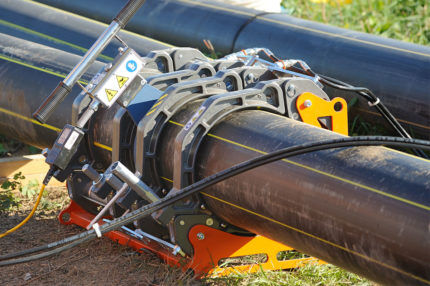
Butt welding can be done by flash and resistance welding. Each option has its own characteristics, pros and cons.
Reflow welding
The essence of welding by this method is that the pipe joints are melted under the influence of a heated tool until they become viscous. Then the ends are connected under pressure and held until completely cooled. The result is a sealed seam.
In order for the connection to be of high quality, it is necessary to press the pieces of the product tightly after heating. The use of modern equipment allows us to partially automate and simplify this work. With its help, the operation of connecting pipes using the melting method is carried out in the shortest possible time.
Resistance welding
The essence of resistance butt welding is that the edges of the pipes are pressed against electrodes, which are equipped with special jaws. This ensures high quality electrical contact. There is no possibility of material slipping between the electrodes.
Then the two pipes are pressed tightly against each other and fixed. Next, the welding current is applied.The contacting areas of the material are melted and combined under pressure into one product. The resulting design has low resistance to oxidation during operation. This significantly limits its scope of application.
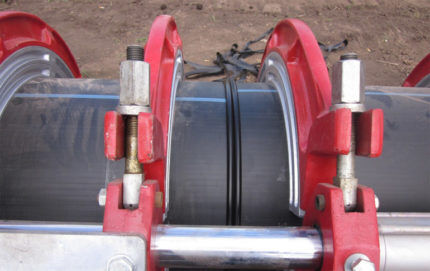
Resistance welding is only suitable for small cross-section pipes. Therefore, in large production, for laying large highways, it is rarely used.
What to choose for polyethylene pipes?
Polyethylene material is often used to lay the pipeline. This is due to its low price and excellent performance characteristics.
It is worth remembering that polyethylene is a dielectric. Therefore, unlike metal, it does not conduct current. To connect products made from it, it is recommended to use the reflow method. It is not possible to make a seam using resistance butt welding on polyethylene. It is necessary to use equipment that heats the sections of two parts.
Fusion welding of polyethylene pipes has a number of features. Firstly, the parts are brought together at low speed. Secondly, the voltage remains constant throughout the entire process. Thirdly, all micro-irregularities disappear due to the uniform supply of the elements being connected. Fourthly, to ensure maximum contact area, the surface of the workpiece is melted.
Can I do the welding myself?
Laying a polyethylene line by butt welding has its own characteristics and differences from other methods of connecting two products.
To carry it out you need certain knowledge and experience. Otherwise, the design will be of low quality and short-lived.
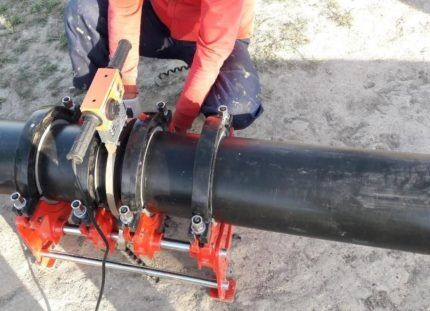
The butt welding method is not easy to implement. Not everyone is able to connect pipes efficiently the first time. If you do not have knowledge and skills in the field of welding, then it is better to contact a professional for laying the line. But he will have to pay a significant amount for the work.
If a person has previously welded using other methods, for example, electrofusion, then he will most likely be able to master butt technology. Therefore, it makes sense to try connection of polyethylene pipes on one's own. But it must be taken into account that the technology of butt welding is more complicated than in the case of connecting polyethylene pipes with an electric coupling.
To do quality work with your own hands, you need to have special equipment. It can be rented. It will be much cheaper than buying a new or used device. It is important to know the step-by-step instructions for flash butt welding and strictly follow them.
Butt welding instructions
Butt welding using flash technology is used to join polyethylene products, in particular pipes. It is also used for installation fittings and other details.
For hard-to-reach, complex areas, this method is not used. In such cases, electrofusion welding is more suitable.
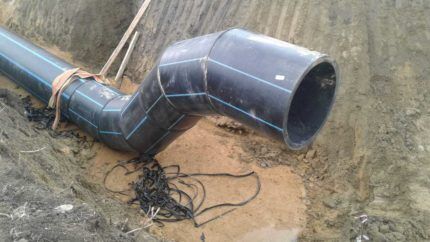
In order for butt welding to be successful and the seam to be neat and durable, it is necessary to adhere to a certain algorithm of actions.
Step-by-step instructions are given below:
- Prepare welding equipment.
- Arrange the necessary conditions.
- Prepare the pipes.
- Carry out welding work.
- Wait until the material cools down and the result is recorded.
Each of these stages has its own characteristics and rules. We will talk about them in more detail below.
Preparation of welding equipment
To weld two sections of polyethylene pipes using the joining method, special equipment is required. It centers, trims, melts and connects the edges of products under the required pressure.
The modern market offers a wide selection of such devices. There are devices with mechanical, hydraulic drive and those equipped with program control. The latter are more convenient to use.
Butt welding machines have a standard design. They necessarily include the following components: a centralizer, a trimmer, a heating element, reducing liners, and a drive.
The centralizer is designed to fix workpieces in the desired position and secure the connecting ends of polyethylene pipes. It is equipped with two moving and two fixed clamps.
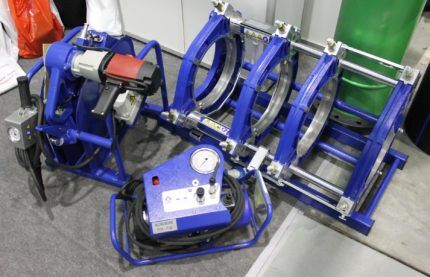
The trimmer allows you to process the cut so that the ends of the two parts are completely in contact.According to the rules, a gap of no more than 0.05 cm is allowed for medium and small diameter pipes.
For large-sized products, this value increases to 0.07 cm. If after the first processing when joining, the gap is greater than the established standard, then the trimmer is used again.
The heating element has the form of a plate coated with Teflon. It follows the shape of the pipe. The drive brings together and connects the heated and molten joints of two products. Gear bearing liners prevent product deformation.
Automated equipment has a control unit equipped with buttons. Such devices ensure simplicity and accuracy of the welding process. This eliminates the possibility of making a mistake.
You just need to correctly position the two pipes that need to be connected and press the appropriate button. Modern equipment is highly productive, but is expensive.
Creating the necessary conditions
Flash butt welding technology is simple to use. But it cannot be used in all cases. It is important to fulfill a number of conditions.
Butt welding is only possible for pipes that are made of the same type of polyethylene and that have the same diameter. The thickness of the walls of the product should not be less than 0.5 cm. It is permissible to perform work only at a certain temperature range: from -15 to +45 degrees.
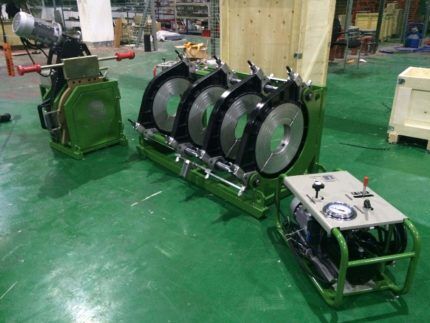
The butt welding method is implemented only if it is possible to reliably fix and press the ends of the pipes being connected to each other.If you have a special device, this will not be a problem.
Preparation of polyethylene pipes
To obtain a high-quality, sealed and aesthetic seam when connecting polyethylene pipes using the butt welding method, you must first prepare the products. The ovality of polyethylene pipelines should be checked. It is recommended to compare the wall thickness. It should be the same.
Also, products should be prepared mechanically. To do this, trimming and milling are used. This will allow the pipes to be connected in the desired position.
It is recommended to use an electric trimmer. He will cut the pipe at the desired angle. It is important that the edges of the workpieces are smooth and completely in contact with each other.
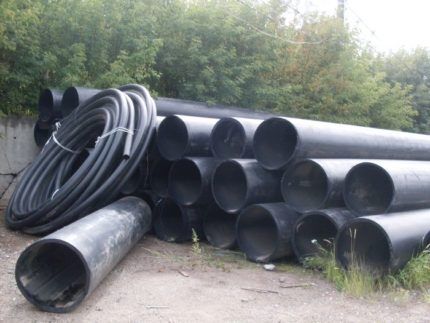
It is necessary to remove contaminants from the surface of the parts - dust, dirt, etc., moisture. This may require two soft, dry rags and a special cleaning agent.
Carrying out butt welding
Butt welding by melting and then joining two parts on your own is best done automatically. This will ensure you get the desired result.

Regardless of whether the equipment for butt welding is automatic or mechanical, the algorithm of actions will be the same.
The process is performed in the following order:
- Place the two pipes that need to be connected by welding in the centralizer and secure them. There should be a distance of about four centimeters between the products;
- remove the chamfer and clean the products;
- simultaneously heat the ends of the pipelines with a welding mirror. Polyethylene material is usually melted to 2 mm. This happens quite quickly;
- carefully remove the heating element;
- tightly connect the heated joints of the pipelines and fix them in this position;
- withstand pressure.
The result should be an even, sealed connection with external welding in the seam area.
Time to complete the process
Reflow welding of polyethylene pipes followed by joining can take varying amounts of time. Much depends on the outer diameter of the workpieces. The larger it is, the longer the material heats up and cools down, the more time is given for the connection.
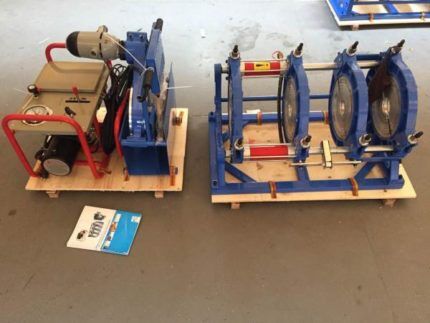
To obtain a strong, tight and neat seam, it is important to know how much to heat the ends of the pipes and withstand the joined products. Similar information is given in the table below.
| Pipe diameter in centimeters | Time to heat the ends of the workpieces in seconds | Time allotted for connection in seconds | Time to cool the joined pipes and obtain a reliable seam in minutes |
| 11,0 | 50 | 12 | 8 |
| 9,0 | 40 | 11 | 8 |
| 7,5 | 30 | 10 | 8 |
| 6,3 | 24 | 8 | 6 |
| 5,0 | 18 | 6 | 4 |
| 4,0 | 12 | 6 | 4 |
| 3,2 | 8 | 6 | 4 |
| 2,5 | 7 | 4 | 2 |
| 2,0 | 7 | 4 | 2 |
| 1,6 | 5 | 4 | 2 |
Most often, butt welding is used for polyethylene pipes with a diameter of more than 5 cm.
General recommendations for welding
When welding polyethylene pipes by fusion, it is very important to follow the instructions. Departure from technology can lead to overheating of the material and the appearance of internal influx. This will disrupt the movement of liquids through the pipes.
Also, the seam may turn out crooked and uneven. In any case, such a design will be considered defective and unsuitable for use.
There are a number of recommendations that must be followed to achieve the desired result. It is important that the walls do not move more than 10% of their thickness during joining. When the material cools, the connected parts must be securely fixed. The time spent removing the heating plate and joining the two ends of the product should be minimal.
It is not recommended to weld non-pressure polymer sewer pipes using the butt method. A roller forms at the junction, on which solid particles can accumulate, leading to clogging of the line.
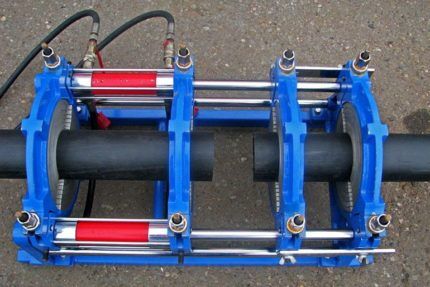
When deciding to lay a pipeline and carry out butt welding, it is recommended that you first familiarize yourself with the provisions of the relevant GOSTs. These documents contain rules, requirements for the quality of work, and the product.
When installing water and gas pipelines, you should focus on GOST R 55276. It describes the technology of butt welding of a polyethylene pipeline.
In relation to equipment for connecting products using a similar method, it is used GOST R ISO 12176-1.
Conclusions and useful video on the topic
The procedure and features of butt welding of polyethylene pipes using a mechanical apparatus:
Butt welding of polyethylene pipes using automatic equipment:
In practice, butt welding of polyethylene pipes with your own hands is not very common. This is due to the fact that to perform such work requires special equipment, a certain level of knowledge and skills.
Butt welding of polyethylene pipes should be carried out in accordance with established requirements and rules. This will ensure a high-quality and durable design. Butt welding has its own technology, features and differences.
You can implement the method yourself, but for this it is important to create the necessary conditions and prepare the pipes properly. If you don’t have a welding machine, then it makes more sense to rent one. It is recommended that you first watch the video on the topic of butt welding. It will be easier to understand the essence of the method and the features of its implementation.
Do you have experience in butt welding of polyethylene pipes? Would you like to share your knowledge in this area or ask questions about welding? Please leave comments, take part in discussions - below is the feedback form.



